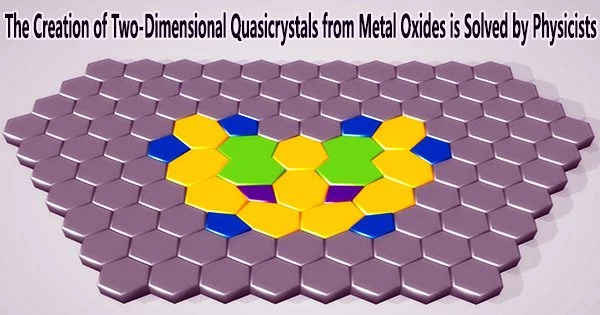Quasicrystals are intricately arranged objects that lack translational symmetry but have long-range order. Quasicrystals have a non-repeating pattern that never completely repeats itself, in contrast to ordinary crystals, which have a repeating pattern.
When barium is added, the two-dimensional titanium oxide structure disintegrates at high temperatures; instead of periodic hexagons, aperiodic rings of four, seven, and ten atoms are produced.
A team at Martin Luther University Halle-Wittenberg (MLU) made this discovery in collaboration with researchers from the Max Planck Institute (MPI) for Microstructure Physics, the Université Grenoble Alpes and the National Institute of Standards and Technology (Gaithersburg, U.S.), thereby solving the riddle of two-dimensional quasicrystal formation from metal oxides. Their findings have been published in Nature Communications.
Hexagons are frequently found in nature. The most well-known example of this structure is honeycomb, although it can also be found in graphene or different metal oxides, including titanium oxide.
“Hexagons are an ideal pattern for periodic arrangements,” explains Dr. Stefan Förster, researcher in the Surface and Interface Physics group at MLU’s Institute of Physics. “They fit together so perfectly that there are no gaps.”
When this team deposited an ultrathin layer of titanium oxide and barium on a platinum substrate and heated it to about 1,000 degrees Celsius in ultra-high vacuum in 2013, they found an astounding finding.
Now that we have a better understanding of the formation mechanisms on the atomic level, we can try to fabricate such two-dimensional quasicrystals on demand in other application-relevant materials like metal oxides or graphene. We are excited to learn whether this special arrangement will produce completely new and useful properties.
Dr. Stefan Förster
The atoms formed themselves into symmetrical shapes with twelve edges, including triangles, squares, and rhombuses. A structure with 12-fold rotational symmetry was created, instead of the expected 6-fold periodicity.
The formation of quasicrystals is influenced by a number of factors, including the properties of the materials used, the geometry of the substrate or template, and the conditions under which the quasicrystals are formed. As a result, the precise methods used to create two-dimensional quasicrystals can vary depending on the desired properties and applications of the resulting structures.
According to Förster, “Quasicrystals were created that have an aperiodic structure. This structure is made of basic atomic clusters that are highly ordered, even if the systematics behind this ordering is difficult for the observer to discern.”
The creation of two-dimensional quasicrystals in metal oxides was originally demonstrated by scientists from Halle.
Since their discovery, the mechanics behind the production of these quasicrystals have remained a mystery. The physicists at MLU have now solved this riddle in collaboration with researchers from the Max Planck Institute for Microstructure Physics Halle, the Université Grenoble Alpes and the National Institute of Standards and Technology (Gaithersburg, U.S.).
They have demonstrated that high temperatures and the presence of barium result in a network of titanium and oxygen rings with four, seven, and ten atoms, respectively. This was done using intricate experiments, energetic calculations, and high-resolution imaging.
“The barium both breaks up the atomic rings and stabilizes them,” explains Förster, who heads the joint project. “One barium atom is embedded in a ring of seven, two in a ring of ten.”
This is feasible because the titanium and oxygen atoms do not chemically connect with the barium atoms, which interact electrostatically with the platinum support.
The team’ most recent discovery goes beyond simply answering a fundamental physics query.
“Now that we have a better understanding of the formation mechanisms on the atomic level, we can try to fabricate such two-dimensional quasicrystals on demand in other application-relevant materials like metal oxides or graphene,” says Förster. “We are excited to learn whether this special arrangement will produce completely new and useful properties.”
















